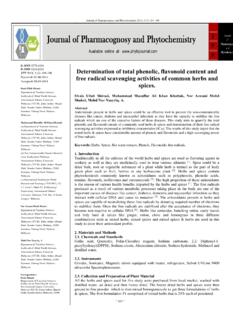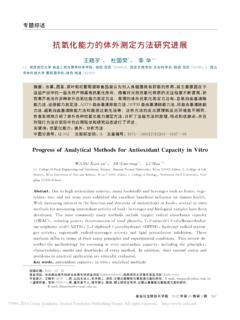Transcription of Extraction methods, qualitative and quantitative ...
1 ~ 29 ~ American Journal of Essential Oils and Natural Products 2017; 5(2): 29-32 ISSN: 2321-9114 AJEONP 2017; 5(2): 29-32 2017 AkiNik Publications Received: 22-02-2017 Accepted: 23-03-2017 Gusthinnadura Oshadie De Silva Department of Food Science and Technology, Faculty of Applied Sciences, University of Sri Jayewardenepura, Sri Lanka Achala Theekshana Abeysundara Department of Food Science and Technology, Faculty of Applied Sciences, University of Sri Jayewardenepura, Sri Lanka Malamige Minoli Weroshana Aponso Department of Food Science and Technology, Faculty of Applied Sciences, University of Sri Jayewardenepura, Sri Lanka Correspondence: Gusthinnadura Oshadie De Silva Department of Food Science and Technology, Faculty of Applied Sciences, University of Sri Jayewardenepura, Sri Lanka Extraction methods, qualitative and quantitative techniques for screening of phytochemicals from plants Gusthinnadura Oshadie De Silva, Achala Theekshana Abeysundara and Malamige Minoli Weroshana Aponso Abstract Phytochemicals are secondary metabolites which have different health benefits and with respect to plants, they possess color, aroma and flavor.
2 There are different Extraction methods of phytochemicals which have been used from the past and which are novel. Those novel techniques are very efficient and they will enable to extract large yields from small amount of plant material. Further, there are some techniques which can be used for both qualitative and quantitative measurements. Gas chromatography, liquid chromatography, high performance liquid chromatography and high performance thin layer chromatographyare some advanced techniques which can be used for quantitative analysis of phytochemicals. The aim of this study is to elaborate different Extraction methods and different qualitative and quantitative techniques for screening phytochemicals from plant materials.
3 Keywords: Phytochemicals, qualitative , quantitative , analysis, chromatography 1. Introduction Phytochemicals are naturally occurring substances found in plants which provides health benefits. These are known as secondary metabolites and may often be created by modified synthetic pathways from primary metabolite or share substrates of primary metabolite origin [5]. Alkaloids, flavonoids, tannins, phenolics, saponin, steroids, glycoside, terpenes and etc. They protect plants from disease and contribute for plant s color, aroma and flavor. Further, they have a role in protection of human health when their dietary intake is significant. Dietary phytochemicals are found in fruits, vegetables, legumes, whole grains, nuts, seeds, fungi, herbs and spices [13].
4 They have antioxidant, anti-inflammatory, anti-cancer and anti-bacterial properties [7]. The Extraction procedures are vital important in analysis of phytochemicals. There are some traditional Extraction methods and novel Extraction methods. Maceration, percolation and soxhlet Extraction methods are prominently used in phytochemical screening studies. But there are some advanced methods such as supercritical fluid Extraction (SFE), microwave assisted (MAE), ultrasound-assisted Extraction (UAE) and accelerated solvent Extraction [2, 12]. 2. Extraction methods Maceration The whole powdered material is allowed to contact with the solvent which is in a stoppered container for a particular time period with frequent agitation [13].
5 At the end of the process the solvent is drained off and the remaining miscella is removed from the plant material through pressing or centrifuging. Maceration is not an advanced technique since active ingredients cannot be totally extracted [12]. Percolation A percolator which has a narrow cone shaped vessel open at both ends is used for this technique [7]. The plant material is moistened with the solvent and allowed to place in a percolation chamber. Then the plant material is rinsed with the solvent for several times until the active ingredient is extracted. The solvent can be used until its point of saturation [12]. Soxhlet Extraction This method is widely used when the desired compound has a limited solubility in the particular solvent and impurities are less soluble in the solvent.
6 ~ 30 ~ American Journal of Essential Oils and Natural Products The finely ground sample is placed ina porous bag or thimble which made out of filter paper or cellulose. The solvent which the desired compounds are going to extracted is kept in the round bottom flask [2]. Supercritical fluid Extraction Supercritical gases such as carbon dioxide, nitrogen, methane, ethane, ethylene, nitrous oxide, sulfur dioxide, propane, propylene, ammonia and sulfur hexafluoride are used to extract active ingredients. The plant material is kept in a vessel which filled with a gas under controlled conditions such as temperature and pressure. The active ingredients which dissolved in the gas separate when both temperature and pressure are lower [11].
7 The important factor of this technique is the mass transfer of the solute in the supercritical solvent. Generally, temperature and pressure has the biggest influence. However the effect of the pressure is more direct. As the pressure increases, higher densities are achieved by the supercritical fluid. Thus the density of the medium increases and the solubility of the solute will be increased. In order to get higher yields the process has to be optimized. Using response surface methodology the optimum parameters can be found [10]. Microwave assisted Extraction In this method microwave energy facilitate the separation of active ingredients from the plant material into the solvent.
8 Microwaves possess electric and magnetic fields which are perpendicular to each other. The electric filed generates heat via dipolar rotation and ionic conduction. As high as the dielectric constant of the solvent, the resulting heating is fast. Unlike the classical methods, microwave assisted Extraction heats the whole sample simultaneously. During the Extraction , heat disrupts weak hydrogen bonds due to dipole rotation of molecules and the migration of dissolved ions increases the penetration of solvent in to the sample or matrix [6]. Ultrasound assisted Extraction This is an advanced technique which has the capability of extracting large amount of bioactive compounds within shorter Extraction time.
9 The main advantage of this technique is the increasing the penetration of solvent into the matrix due to disruption of cell walls produced by acoustical cavitations. And also this achieves at low temperatures and hence this is more suitable for Extraction of thermally unstable compounds [8]. Accelerated solvent Extraction In accelerated solvent Extraction technique, solvents are used at elevated temperatures and pressures to keep the solvent in liquid form during the Extraction process. Due to elevated temperature the capacity of the solvent to solubilize the analytes increases and thus the diffusion rate increases. A further, higher temperature reduces the viscosity and the solvent can easily penetrate the pores of the matrix.
10 The pressurized solvent enables more close contact with the analytes and solvent. However, this method uses less time and less amount of solvent for the Extraction of active ingredients. The advantages of this method are extractions for sample sizes 1-100g in minutes, dramatic solvent reduction and wide range of applications and handling of acidic and alkaline matrices [9]. 3. qualitative techniques for the determination of phytochemicals Alkaloids Mayer s test Two drops of Mayer s reagent are added along the sides of test tube in to few amount of plant extract. The presence of alkaloids is indicated by a white creamy precipitate [3]. Wagner s test A few drops of Wagner s reagent are added to a few amount of plant extract and a reddish brown precipitate depicts the presence of alkaloids [3].

